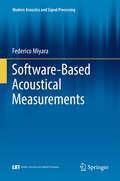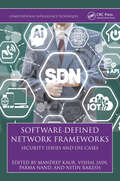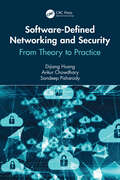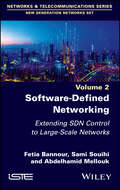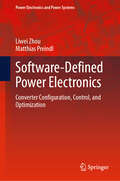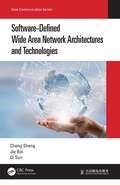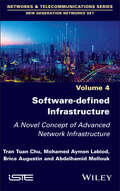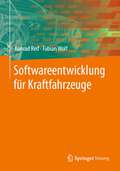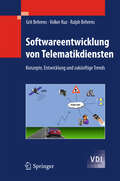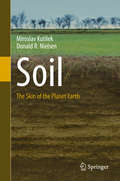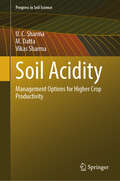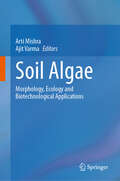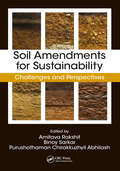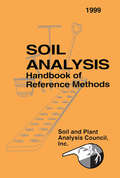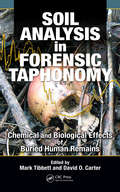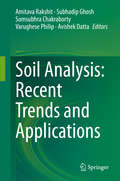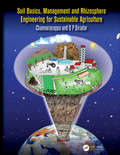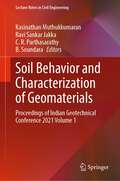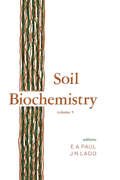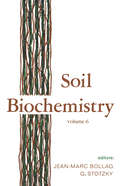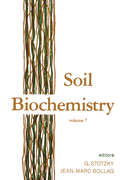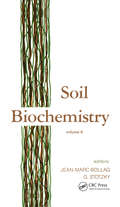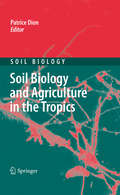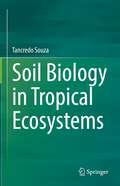- Table View
- List View
Software-Based Acoustical Measurements
by Federico MiyaraThis textbook provides a detailed introduction to the use of software in combination with simple and economical hardware (a sound level meter with calibrated AC output and a digital recording system) to obtain sophisticated measurements usually requiring expensive equipment. It emphasizes the use of free, open source, and multiplatform software. Many commercial acoustical measurement systems use software algorithms as an integral component; however the methods are not disclosed. This book enables the reader to develop useful algorithms and provides insight into the use of digital audio editing tools to document features in the signal. Topics covered include acoustical measurement principles, in-depth critical study of uncertainty applied to acoustical measurements, digital signal processing from the basics, and metrologically-oriented spectral and statistical analysis of signals. The student will gain a deep understanding of the use of software for measurement purposes; the ability to implement software-based measurement systems; familiarity with the hardware necessary to acquire and store signals; an appreciation for the key issue of long-term preservation of signals; and a full grasp of the often neglected issue of uncertainty in acoustical measurements. Pedagogical features include in-text worked-out examples, end-of-chapter problems, a glossary of metrology terms, and extensive appendices covering statistics, proofs, additional examples, file formats, and underlying theory.
Software-Defined Network Frameworks: Security Issues and Use Cases (Computational Intelligence Techniques)
by Vishal Jain Nitin Rakesh Parma Nand Mandeep KaurSoftware-Defined Networks (SDN) work by virtualization of the network and the Cognitive Software-Defined Network (CSDN) combines the efficiencies of SDN with cognitive learning algorithms and enhanced protocols to automatize SDN. Partial deployment of SDN along with traditional networking devices forms a Hybrid Software-Defined Network (HSDN). Software-Defined Network Frameworks: Security Issues and Use Cases consolidates the research relating to the security in SDN, CSDN, and Hybrid SDNs. The security enhancements derived from the use of various SDN frameworks and the security challenges thus introduced, are also discussed. Overall, this book explains the different architectures of SDNs and the security challenges needed for implementing them.Features: Illustrates different frameworks of SDN and their security issues in a single volume Discusses design and assessment of efficient SDN northbound/southbound interfaces Describes cognitive computing, affective computing, machine learning, and other novel tools Illustrates coupling of SDN and traditional networking – Hybrid SDN Explores services, technologies, algorithms, and methods for data analysis in CSDN The book is aimed at researchers and graduate students in software engineering, network security, computer networks, high performance computing, communications engineering, and intelligent systems.
Software-Defined Networking and Security: From Theory to Practice (Data-Enabled Engineering)
by Dijiang Huang Ankur Chowdhary Sandeep PisharodyThis book provides readers insights into cyber maneuvering or adaptive and intelligent cyber defense. It describes the required models and security supporting functions that enable the analysis of potential threats, detection of attacks, and implementation of countermeasures while expending attacker resources and preserving user experience. This book not only presents significant education-oriented content, but uses advanced content to reveal a blueprint for helping network security professionals design and implement a secure Software-Defined Infrastructure (SDI) for cloud networking environments. These solutions are a less intrusive alternative to security countermeasures taken at the host level and offer centralized control of the distributed network. The concepts, techniques, and strategies discussed in this book are ideal for students, educators, and security practitioners looking for a clear and concise text to avant-garde cyber security installations or simply to use as a reference. Hand-on labs and lecture slides are located at http://virtualnetworksecurity.thothlab.com/. Features Discusses virtual network security concepts Considers proactive security using moving target defense Reviews attack representation models based on attack graphs and attack trees Examines service function chaining in virtual networks with security considerations Recognizes machine learning and AI in network security
Software-Defined Networking: Extending SDN Control to Large-Scale Networks
by Abdelhamid Mellouk Fetia Bannour Sami Souihi<p>This book reviews the concept of Software-Defined Networking (SDN) by studying the SDN architecture. It provides a detailed analysis of state-of-the-art distributed SDN controller platforms by assessing their advantages and drawbacks and classifying them in novel ways according to various criteria.<p> <p>Additionally, a thorough examination of the major challenges of existing distributed SDN controllers is provided along with insights into emerging and future trends in that area.<p> <p>Decentralization challenges in large-scale networks are tackled using three novel approaches, applied to the SDN control plane presented in the book. The first approach addresses the SDN controller placement optimization problem in large-scale IoT-like networks by proposing novel scalability and reliability aware controller placement strategies. The second and third approaches tackle the knowledge sharing problem between the distributed controllers by suggesting adaptive multilevel consistency models following the concept of continuous Quorum-based consistency. These approaches have been validated using different SDN applications, developed from real-world SDN controllers.<p>
Software-Defined Power Electronics: Converter Configuration, Control, and Optimization (Power Electronics and Power Systems)
by Liwei Zhou Matthias PreindlPower electronic devices and systems are attracting growing attention due to the electrification of energy conversion systems being a key factor in efforts to reduce fuel combustion and achieve carbon neutrality. This book provides a concept of software-defined power electronics architecture to generalize the power converter design and control procedures with various interfaced applications. The ultimate objective is to construct a reconfigurable software-defined power electronics architecture with standardized atomic power modules that can be leveraged for different electrified energy resources, such as electric vehicle charging, electric motor traction, solar power, and wind power. Several advanced control and design techniques are introduced in detail to achieve the proposed concept with a high-performance energy conversion system, including optimization-based control and estimation, variable frequency soft switching, and passive component design and optimization. The proposed generalized architecture also contributes to avoiding redundant hardware and algorithms design procedures. Software-Defined Power Electronics: Converter Configuration, Control, and Optimization is a guide for engineers and academic researchers to the highly specialized skills required for working in the fields of power converter design and development.
Software-Defined Wide Area Network Architectures and Technologies (Data Communication Series)
by Cheng Sheng Jie Bai Qi SunStarting with problems and challenges faced by enterprise WANs, Software-Defined Wide Area Network Architectures and Technologies provides a detailed description of SD-WAN’s background and basic features, as well as the system architecture, operating mechanism, and application scenarios of the SD-WAN solution based on the implementation of Huawei SD-WAN Solution. It also explains key SD-WAN technologies and analyzes real SD-WAN deployment cases, affording readers with design methods and deployment suggestions for the SD-WAN solution. The information presented in this book is easy to understand and very practical. It enables you to become adept in the SD-WAN solution’s implementation and design principles. The book is intended for ICT practitioners, such as network technical support engineers, network administrators, and network planning engineers, to use in studying theory. Furthermore, it serves as reference material for network technology enthusiasts. Authors Cheng Sheng is the Chief Architect of Huawei’s SD-WAN Solution. He has nearly 20 years of experience in network product and solution design, as well as extensive expertise in product design and development, network planning and design, and network engineering project implementation. Jie Bai is an Architect of Huawei’s SD-WAN Solution. He is well versed in Huawei security products and SD-WAN Solution and has written books such as Huawei Firewall Technology Talk as well as Huawei Anti-DDoS Technology Talk. Qi Sun is a Senior Information Architect of Huawei, and he is knowledgeable in Huawei SD-WAN Solution, CloudVPN Solution, and Cloud Management Solution. He also participated in the information architecture design and delivery of multiple solutions.
Software-defined Infrastructure: A Novel Concept of Advanced Network Infrastructure (ISTE Invoiced)
by Abdelhamid Mellouk Tran Tuan Chu Mohamed Aymen Labiod Brice AugustinIn the era of the Internet of Things (IoT) and Digital Twins (DT), network infrastructures are rapidly evolving to meet industrial demands. Thus, we were motivated to explore the changing landscape of network deployment, management and utilization, driven by the rise of connected devices and emerging challenges. Software-defined Infrastructure focuses on the cutting-edge shift in hardware deployment and communication management methods, which enable unified, scalable and adaptive network management to support Healthcare IoT (H-IoT) communication, where real-time data transmission is essential to system success. The book presents a novel network concept and solutions for tackling the challenges in key areas such as 5G, and beyond, in network management, multipath transport protocols and edge computing. This book aims to simplify network management, improve remote patient monitoring communication and enhance patient outcomes. Through case studies and theoretical models, the book offers insights into the transformation of advanced networks in the H-IoT context and lays the foundation for innovative ideas in this research domain.
Softwareentwicklung für Kraftfahrzeuge
by Konrad Reif Fabian WolfIm ersten Teil dieses Lehrbuchs werden Funktions- und Softwareentwicklung für Kraftfahrzeuge eingeführt. Dabei wird auf den Prozess der strukturierten Funktions- und Softwareentwicklung von der Erhebung der Anforderungen über die Softwareerstellung bis zum Test sowie Reifegradmodelle eingegangen.Im zweiten Teil werden diese Prozesse aus Wissenschaft und Lehre mit etablierten Vorgehensweisen aus der industriellen Praxis konkretisiert. Die pragmatische Beschreibung der konkreten Vorgehensweisen ist eine Basis für die Ausgestaltung detaillierter Prozesse im Unternehmensalltag sowie deren tägliche Anwendung im Projektgeschäft.
Softwareentwicklung von Telematikdiensten
by Grit Behrens Volker Kuz Ralph BehrensDas Buch vermittelt einen Einstieg in die Software-Entwicklung von Telematikdiensten mit einem Eclipse-Plugin für das Common Service Framework (Open Source). Ziel ist es, Nutzer dazu zu befähigen, internetbasierte Telematikdienste selbst zu programmieren. Begleitend zum Buch steht ein Internetportal bereit, wo Beispielapplikationen demonstriert, getestet oder weiter entwickelt werden können. Es gibt des Weiteren Einblick in die Hintergründe und die weltweiten Zukunftsentwicklungen auf dem rasant anwachsenden Gebiet der Telematikdienste.
Soil
by Miroslav Kutílek Donald R. NielsenThe main focus of this monograph is to explain the important role of soil and the environment to a broad audience. Soil is one of the five essential factors crucial for human life. On the one hand the authors describe a responsible approach and use of soil, established on a basic knowledge of the nature of soil and the countless ongoing processes within soil. On the other hand they explain the precarious link between soil and regional environment, which is indispensable for plant and animal communities. In addition to these topics its chapters describe the unique roles of soil texture, soil structure and soil pore systems in hydrologic cycles, plant nutrition and conditions affecting the preservation or eventual extinction of soil. This book concludes with the principles of soil protection and revitalization. General readers with an interest in biology, chemistry, physics or geology will find this book highly informative.
Soil Acidity: Management Options for Higher Crop Productivity (Progress in Soil Science)
by Vikas Sharma U. C. Sharma M. DattaThe book on acid soils offers a thorough analysis of the degree of soil acidity at the global level, information on the biota, chemistry, and behaviour of acid soils, as well as the mechanisms by which plants tolerate soil acidity. It also offers crop management strategies that make effective use of amendments and acid soil-specific crop management practices. Crop output, forest health, and aquatic life all suffer from acidic soil. The main causes are the toxicity of aluminium (Al) and/or manganese (Mn), as well as the deficiencies of calcium (Ca), magnesium (Mg), phosphorus (P), and molybdenum (Mo), to a lesser extent. Lack of calcium affects the health and integrity of cells, which lowers agricultural yield and quality. To achieve the highest crop productivity, management options have been provided. All concerned will find this book of great assistance in solving the global food crisis in a sustainable manner.
Soil Algae: Morphology, Ecology and Biotechnological Applications
by Ajit Varma Arti MishraThis book collates updated knowledge about algal species which are present in the terrestrial environment particularly in soil. Contributions in this volume covers different topics such as morphology, ecology and applications of soil algae. Ecological significance of soil algae and their biotechnological importance are the key features of this book. Algae are ubiquitous and occur in almost all terrestrial environments and in soil, they majorly belong to the member of Chlorophycophyta, Cyanochloronta, Rhodophycophyta Euglenophycophyta, and Chrysophycophyta. The role of soil algae as fertilizer and for reclaiming the saline soil is well studied. Algae in soil benefits agricultural production, increase water retention capacity, reduced soil erosion, reduction of nutrient runoff, and provides nutrients. The added algae increase soil biodiversity, organic biomass, and the total humus content of the soil, beneficial for healthy soil. These soil algae diversities also have many biotechnological and industrial importance. This book is of interest and use to researchers of phycology, molecular biology, agriculture and biotechnology and also to scientists working on soil biology, agronomy and crop research. Also, the book serves as reading material for undergraduate and graduate students of microbiology, agriculture, molecular biology, and biotechnology. Researchers from biotechnological and biofertilizers companies will also find this to be a useful read.
Soil Amendments for Sustainability: Challenges and Perspectives
by Amitava Rakshit Binoy Sarkar Purushothaman AbhilashThis book focuses on the pros and cons of amendment materials to restore the functioning of soil resources. It presents a holistic overview on affected land revitalization, clean up and revegetation using these amendments that could be implemented in the long term management of the soil-plant-atmosphereanimal continuum.
Soil Analysis Handbook of Reference Methods
by Soil and Soil and Plant Analysis Council Inc.For more than 30 years, soil testing has been widely used as a basis for determining lime and fertilizer needs. Today, a number of procedures are used for determining everything from soil pH and lime requirement, to the level of extractable nutrient elements. And as the number of cropped fields being tested increases, more and more farmers and growers will come to rely on soil test results. But if soil testing is to be an effective means of evaluating the fertility status of soils, standardization of methodology is essential. No single test is appropriate for all soils.Soil Analysis Handbook of Reference Methods is a standard laboratory technique manual for the most commonly used soil analysis procedures. First published in 1974, this Handbook has changed over the years to reflect evolving needs. New test methods and modifications have been added, as well as new sections on nitrate, heavy metals, and quality assurance plans for agricultural testing laboratories. Compiled by the Soil and Plant Analysis Council, this latest edition of Soil Analysis Handbook of Reference Methods also addresses the major methods for managing plant nutrition currently in use in the United States and other parts of the world. For soil scientists, farmers, growers, or anyone with an interest in the environment, this reference will prove an invaluable guide to standard methods for soil testing well into the future.Features
Soil Analysis in Forensic Taphonomy: Chemical and Biological Effects of Buried Human Remains
by Mark Tibbett David O. CarterA burial environment is a complex and dynamic system. It plays host to an abundance of interdependent chemical, physical, and biological processes, which are greatly influenced by the inclusion of a body and its subsequent decay. However, while taphonomy continues to emerge as a valuable forensic tool, until now most of the attention has been on th
Soil Analysis: Recent Trends and Applications
by Amitava Rakshit Subhadip Ghosh Somsubhra Chakraborty Varughese Philip Avishek DattaSoil analysis is critically important in the management of soil-based production systems. In the absence of efficient methods of soil analysis our understanding of soil is pure guesswork. Ideally the pro-active use of laboratory analysis leads to more sustainable soil productivity. Unfortunately, most of the world’s agriculture is still reactionary, waiting for obvious yield declines to occur before taking action to identify the reasons. The modern soil laboratory is pivotal to informing soil managers what adaptive practices are needed to address chemical and physical imbalances before they occur, and the intelligent adaptive use of laboratory data not only greatly speeds up and reduces the cost of empirical soil study, but can even render it unnecessary. This book provides a synopsis of the analytical procedures used for soil analysis, discussing the common physical, chemical and biological analytical methods used in agriculture and horticulture. Written by experienced experts from institutions and laboratories around the globe, it provides insights for a range of users, including those with limited laboratory facilities, and helps students, teachers, soil scientists and laboratory technicians increase their knowledge and skills and select appropriate methods for soil analysis.
Soil Basics, Management and Rhizosphere Engineering for Sustainable Agriculture
by Channarayappa C. D P BiradarIncrease in global population, drastic changes in the environment, soil degradation and decrease in quality and quantity of agricultural productivity warranted us to adapt sustainable farming practices. This book focuses on soil health management and creating biased rhizosphere that can effectively augment the needs of sustainable agriculture.
Soil Behavior and Characterization of Geomaterials: Proceedings of Indian Geotechnical Conference 2021 Volume 1 (Lecture Notes in Civil Engineering #296)
by C. R. Parthasarathy Kasinathan Muthukkumaran Ravi Sankar Jakka B. SoundaraThis book comprises the select peer-reviewed proceedings of the Indian Geotechnical Conference (IGC) 2021. The contents focus on Geotechnics for Infrastructure Development and Innovative Applications. The book covers topics related to soil behavior and characterization of geomaterials, geotechnical, geological, and geophysical investigation of special topics such as behavior of unsaturated soils, offshore and marine geotechnics, remote sensing and GIS, instrumentation and monitoring, retrofitting of geotechnical structures, reliability in geotechnical engineering, geotechnical education, codes and standards, among others. This volume will be of interest to those in academia and industry.
Soil Biochemistry
by E. A. Paul J.N. LaddThis book reviews some aspects of soil biochemistry, including the biochemical turnover of specific elements and organic compounds in soil; the properties and functions of soil enzymes; and the structure, distribution and pathways of metabolism of organic compounds.
Soil Biochemistry, Volume 10 (Books in Soils, Plants, and the Environment)
by Jean-Marc Bollag G. Stotzky Dejan PlavsicAn exploration of the most complex microbial ecosystems with incisive reviews of developments in soil science. It presents techniques of chemical analysis, refinements of environmental protection measures, and methods for maximizing agricultural yields. It also addresses a wide range of biochemical processes and practical applications of advanced b
Soil Biochemistry: Volume 6: Volume 6 (Books In Soils, Plants, And The Environment Ser. #15)
by J.-M. BollagExplores the role of biochemical processes in the soil environment, particularly the activity of microorganisms, and the potential application of those processes to environmental biotechnology. The 11 papers also highlight the application of molecular biology and microbial genetics to soil biology a
Soil Biochemistry: Volume 7
by Jean-Marc Bollag G. StotzkyThis book describes the interactions between soil minerals and microorganisms to more specialized areas such as the formation of desert varnishes. It is helpful for scientists and students who want to extend their knowledge of and research into soil biochemistry.
Soil Biochemistry: Volume 8
by Jean-Marc Bollag G. StotzkyStressing the potential application of biochemical processes in soil to environmental biotechnology, this state-of-the-art reference considers the vital role that such biochemical processes have in the environment - emphasizing the activity of micro-organisms in soil.;An up-to-date analysis of biological reactions in soil, Volume 8 of Soil Biochemistry highlights: traditional as well as molecular and immunlogical techniques for detecting specific micro-organisms in soil; the fate of introduced genetically-modified organisms; the problem of competition by the indigenous microbial populations with the introduced organisms; the use of a white rot fungus, Phanerochaete chrysosporium, for bioremediative purposes in soil; the interaction of xenobiotics, such as pesticides, with soil organisms; generic microbial metabolism and degradation pathways; the inhibition of the nitrification process by allelochemicals released by plants; the microbial mineralization of various compounds under anaerobic conditions, explaining its importance in the global carbon cycle; the formation of soil organic matter, particularly in forest soils; and CPMAS 13C-NMR spectroscopy, a major analytical technique to determine the chemicals or chemical groups involved in the humification process.;Presenting a multidisciplinary approach to the field by internationally acclaimed scientists, Soil Biochemistry, Volume 8 is intended for professionals and students in the fields of soil science; microbiology; biochemistry; environmental science, engineering and technology; biogeochemistry; biotechnology; agronomy; plant pathology; and microbial ecology.
Soil Biology and Agriculture in the Tropics
by Patrice DionThe relationships between soils, microbes and humans are of crucial relevance in the tropics, where plant stress and microbial activity are exacerbated. This volume of Soil Biology presents the living component of tropical soils, showing how it is shaped by environmental conditions and emphasizing its dramatic impact on human survival and well-being. Following an introduction to the specificities of tropical soils and of their microbial communities, the biological aspects of soil management are examined, dealing with land use change, conservation and slash-and-burn agriculture, the restoration of hot deserts, agroforestry and paddy rice cultivation. As they are of particular relevance for tropical agriculture, symbioses of plants and microbes are thoroughly covered, as are the biodegradation of pesticides and health risks associated with wastewater irrigation. Lastly, traditional soil knowledge is discussed as a key to our sustainable presence in this world.
Soil Biology in Tropical Ecosystems
by Tancredo SouzaThis textbook explores the complex nature of soil biological communities and their environments, and covers deserts, rainforests, seasonal tropical forests, dry deciduous forests, and island environments in the tropical zone. It provides essential information on soil biology concepts, ecological processes, plant-soil feedback, trophic structure, and land use effects on soil’s biological properties. The book also offers an updated approach to soil biota and microbiota and their interactions with plants that regulate the structures and functions of tropical ecosystems. Uniquely, it addresses island environments and natural disasters, shedding new light on soil organisms recovering tropical ecosystem functions. Further topics include ecological processes, plant-soil interactions, trophic communities, molecular approaches, and land use, making the book a valuable asset for students, educators and researchers engaged in the Environmental Sciences, Biodiversity and Conservation, Soil Ecology, Soil Biology, Ecology, Zoology, and Soil Biota Classification using classical and molecular tools.
